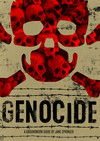
"First they came for the Communist - so I said nothing. Then they came for the Social Democrats, but I was not a Social Democrat - so I said nothing. Then came the trade unionists, but I was not a trade unionist. And then they came for the Jews, but I was not a Jew - so I did little. Then when they came for me, there was no one left who could stand up for me." - Martin Niemoeller, Protestant Pastor, Nazi Victim (p. 56)
This book barely scratches the surface of genocide plaguing society, and countries like the US's proverbial blinders when they have nothing to gain from stopping it.
It takes a very basic look at genocides that have been performed throughout history leading into present day. First, it sets the context by defining "genocide" - stemming from Lemkin's (1946) combination of genos meaning "race" and cide meaning "to kill" - and walking the reader through criteria used to classify mass killings. In addition, using the genocide of the Jews during WWII as a reference point, the book goes on to compare and contrast current day genocides in Darfur, Rwanda, Uganda, and many more. It goes on to chronicle the warning signs of developing genocides as well as the UN's responsibility to intervene - even though it almost never does until it's too late.
This brief book gives a quick and dirty look at genocide throughout the world and multiple countries' refusal to stop it. The most sickening part of the entire book is the
realization that the US is almost always "inadvertently" involved in the killings. Why? Because the people under attack have minerals, or some other resource, that the US wants. In addition, in the case of poor countries experiencing genocide, the US uses its influential power to convince other countries not to provide aid until it's too late. Springer provides documented proof over and over again to show the twisted version of humanity that the US
government practices.
Although this book effectively builds its argument by creating a strong foundation of evidence and logic, it is very repetitive and dense in places. Also, the information reads like a timeline, and doesn't go as much in depth as a reader might hope. However, this book gives readers a
starting point and references if they wish to research its claims for themselves.
This would be an excellent resource for teachers to use while teaching a Holocaust unit because it connects the past to the present. In addition, it addresses the impact of propaganda and media control on genocide, which is a growing concern among the public at large - who owns the information, and how do we know it's accurate? The chapters are written in such a way that they could be standalone if a teacher didn't want to, or have the time to, read the entire book as a class.
This book was published in 2006, which means that it's
already out of date, and more genocides have already occurred.
This book barely scratches the surface of genocide plaguing society, and countries like the US's proverbial blinders when they have nothing to gain from stopping it.
It takes a very basic look at genocides that have been performed throughout history leading into present day. First, it sets the context by defining "genocide" - stemming from Lemkin's (1946) combination of genos meaning "race" and cide meaning "to kill" - and walking the reader through criteria used to classify mass killings. In addition, using the genocide of the Jews during WWII as a reference point, the book goes on to compare and contrast current day genocides in Darfur, Rwanda, Uganda, and many more. It goes on to chronicle the warning signs of developing genocides as well as the UN's responsibility to intervene - even though it almost never does until it's too late.
This brief book gives a quick and dirty look at genocide throughout the world and multiple countries' refusal to stop it. The most sickening part of the entire book is the
realization that the US is almost always "inadvertently" involved in the killings. Why? Because the people under attack have minerals, or some other resource, that the US wants. In addition, in the case of poor countries experiencing genocide, the US uses its influential power to convince other countries not to provide aid until it's too late. Springer provides documented proof over and over again to show the twisted version of humanity that the US
government practices.
Although this book effectively builds its argument by creating a strong foundation of evidence and logic, it is very repetitive and dense in places. Also, the information reads like a timeline, and doesn't go as much in depth as a reader might hope. However, this book gives readers a
starting point and references if they wish to research its claims for themselves.
This would be an excellent resource for teachers to use while teaching a Holocaust unit because it connects the past to the present. In addition, it addresses the impact of propaganda and media control on genocide, which is a growing concern among the public at large - who owns the information, and how do we know it's accurate? The chapters are written in such a way that they could be standalone if a teacher didn't want to, or have the time to, read the entire book as a class.
This book was published in 2006, which means that it's
already out of date, and more genocides have already occurred.


















